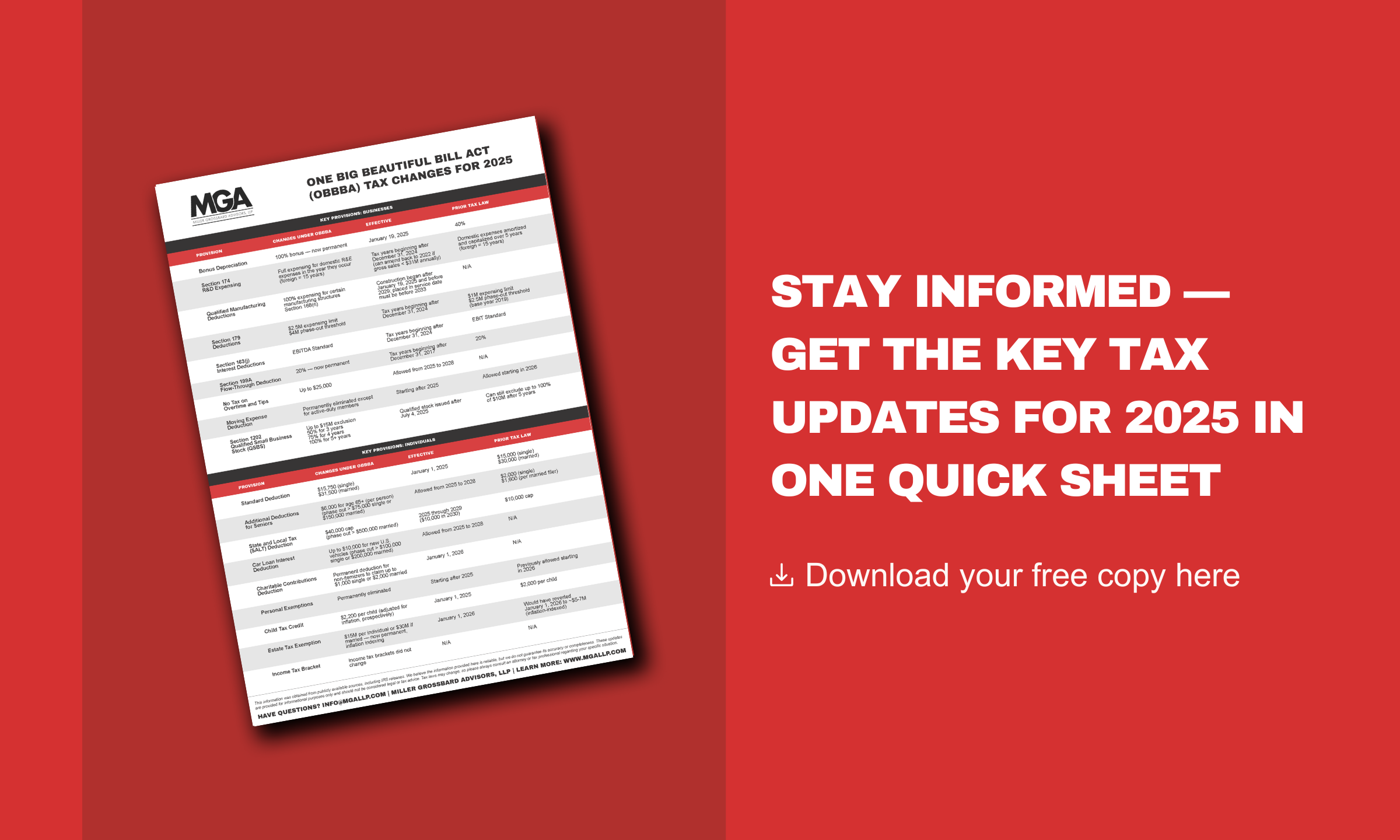Congress and the IRS make everything complex, especially this year as they passed the 2018 Tax Cuts and Jobs Act. With the majority of changes from the TCJA going into effect this year, we want to help simplify this for you and provide you with the necessary information to make smart decisions.
While many of these changes may not impact you immediately in 2018, they should still be considered for tax planning purposes. As Congress continues to issue clarifications and as the IRS works to update forms impacted by these changes, we at MGA are staying on top of it all for you. Our tax team is continually monitoring recent developments and issued guidance so we can be prepared to handle the complex reporting that will impact 2018 and future tax years.
In this blog, we have compiled the most relevant and impactful changes that were enacted. And as we continue to prepare for the tax season ahead, we will be detailing out specifics on some of the more complex tax issues highlighted below.
POTENTIALLY FAVORABLE |
|||||||||||||
| For individuals-highest tax rate at 37% (down from 39.6%); Amount of income to achieve top tax bracket increased | |||||||||||||
| $2,000 per dependent under 16 yrs of age; $500 credit allowed for dependents over 16 yrs of age | |||||||||||||
| Itemized deductions were previously subject to a reduction (3% of Adjusted Gross Income) for taxpayers with income over a certain threshold; this limitation is now repealed | |||||||||||||
| 100% bonus depreciation for qualified property placed in service after 9/27/17 (versus 50% previously allowed) | |||||||||||||
| Potential 20% deduction for individual taxpayers with Qualified Business Income | |||||||||||||
| Effective Jan. 2019, no penalty imposed for failing to maintain minimum essential coverage **The requirement is still in effect for the 2018 tax year | |||||||||||||
|
|||||||||||||
|
For individuals, the AMT threshold increased from $187,800 to $191,500; exemption amounts increased significantly to $109,400 for Married Filing Joint (up from $84,500) and $70,300 for Single/Head of Household Filers (up from $54,300) |
|||||||||||||
POTENTIALLY UNFAVORABLE |
|
| $10,000 aggregate limit for state income, property, and sales taxes paid | |
| Limitation on deductible interest for loans exceeding $750K (previously limited if loans exceeded $1MIL); existing loans, however, are grandfathered in | |
| Losses attributable to any trade or business are limited to gross income or gain + $500,000 for married filing joint and $250,000 for single filers. Passive Loss rules apply before this limitation. **Any loss disallowed is carried forward as an NOL | |
| No longer deductible by payor but also not reportable as income by recipient | |
| Exemptions are no longer allowed starting with 2018 tax year; taxpayers were previously allowed a potential deduction of up to 4,000 per exemption claimed | |
| Child's unearned income is now taxed at trust/estate tax brackets (as opposed to parent's tax rate); Child's earned income is taxed at single taxpayer's rates | |
| Business related entertainment expenses are no longer deductible; previously allowed as 50% deduction. **In general, Business Meals expense still subject to prior rules | |
| No longer allowed as a deduction unless the casualty occurred due to a Federally declared disaster area | |
| For NOL's arising after 12/31/17, NOL deduction limited to 80% of taxable income (without regard to the NOL); excess loss is carried forward. NOL no longer allowed to be carried back | |
| Miscellaneous itemized deductions (investment fees, unreimbursed employee expenses, tax preparation fees, etc.) are no longer deductible; previously allowed to extent these deductions exceeded 2% of Adjusted Gross Income | |
As we prepare our clients’ tax returns this upcoming year, we will be diving deeper by asking additional questions and clarifying information provided to ensure that we are not only compliant but also proactive in our approach to your specific tax needs and goals.
With the uncertainty of changing tax laws, MGA has the experts and experience to act quickly. Our team is ready to help you with tax planning today.
.png?width=191&name=mgalogofinal-01%20(3).png)





